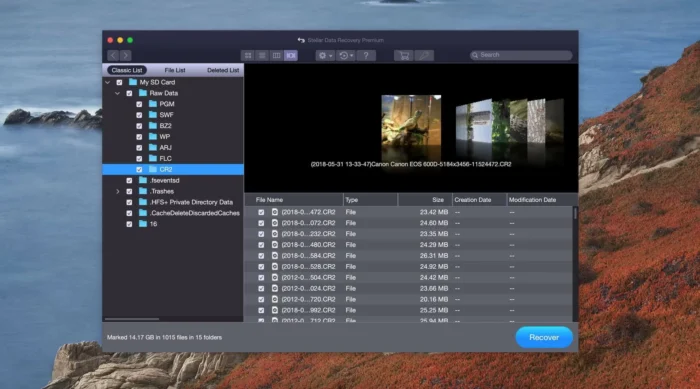
Photographs are more than just pixels on a screen or ink on paper—they are windows into our past, encapsulating precious memories and cherished moments. However, the heartbreak of accidentally deleting photos can be overwhelming. But fear not!
The Power of Data Recovery Software: A Savior for Lost Memories
With its advanced algorithms and scanning capabilities, data recovery software can delve deep into your storage media, locate deleted photos, and restore them to their original state. It is a beacon of light when cherished memories are accidentally erased or seemingly lost forever. By harnessing the power of data recovery software, you can reclaim those lost moments and preserve them for future generations, ensuring that your precious memories are never truly gone. One such potent tool made especially for recovering deleted or lost images from various storage media is the Stellar Photo Recovery program.

Choosing the Right Recovery Software: Features to Look for
When it comes to recovering deleted photos, choosing the right data recovery software is crucial. With numerous options available in the market, it can be overwhelming to determine which software will best suit your needs. To help you make an informed decision, here are some key features to look for when selecting recovery software:
Compatibility: Ensure that the software is compatible with your operating system and the device from which you need to recover the deleted photos. Whether you are using Windows, macOS, or a mobile platform, make sure the software supports your specific environment.
Scanning Capabilities: Opt for software that offers comprehensive scanning capabilities. It should be able to perform both quick scans and deep scans to thoroughly search for deleted files on your device or storage media. A deep scan is particularly important as it can recover files that may not be found through a quick scan.
File Formats Supported: Check if the software supports a wide range of file formats, including popular image formats such as JPEG, PNG, RAW, and others. This ensures that you can recover photos in the formats you need, regardless of the camera or device used to capture them.
User-Friendliness: Look for software that has an intuitive and user-friendly interface. The recovery process should be straightforward, even for those who are not tech-savvy. A well-designed interface with clear instructions and easy-to-navigate features will make the recovery process smoother and less daunting.
Preview Functionality: A crucial feature to consider is the ability to preview recovered photos before finalizing the recovery process. This allows you to selectively recover only the photos that you want, saving time and storage space.
Reliability and Success Rate: Research the reputation and success rate of the recovery software you are considering. Read customer reviews and testimonials to gauge its reliability and effectiveness in recovering deleted photos. Choose software that has a proven track record and positive user feedback.
Additional Features: Some recovery software may offer additional features such as the ability to recover photos from formatted or corrupted storage media, create disk images for safe recovery attempts, or provide a secure erase option for permanently deleting sensitive files.

How to keep your photos safe?
Here are some essential tips to ensure the safety of your precious memories:
- Regular Backups: The most effective way to safeguard your photos is by creating regular backups. Use an external hard drive, cloud storage services, or both to store copies of your images. Automated backup software can simplify this process by scheduling backups at specified intervals, providing peace of mind by knowing that your pictures are securely stored.
- Organize and Label: Implement a well-organized file structure for your photos. Create folders with descriptive names and subfolders based on categories, dates, or events. Additionally, consider adding relevant keywords or tags to enable quick searching and retrieval when needed.
- Multiple Storage Locations: To minimize the risk of losing your pictures, consider storing them in multiple locations. In addition to keeping them on your computer’s hard drive, use external hard drives, USB flash drives, or cloud storage services to have redundant copies. This way, if one storage device fails, you’ll still have access to your photos.
- Protect Against Hardware Failure: Hard drive failures can result in data loss, so it’s important to protect against this risk. Regularly check your hard drive’s health using diagnostic tools and replace it if necessary. Consider using solid-state drives (SSDs) that have no moving parts and are generally more reliable than traditional hard drives.
- Use Antivirus Software: Protecting your computer from malware and viruses is crucial to ensure the safety of your pictures. Install reputable antivirus software and keep it up to date. Regularly scan your computer for any potential threats that could compromise your images.
- Avoid Data Corruption: To prevent data corruption, be cautious when transferring or editing your pictures. Always use safe and reliable methods to transfer files, such as USB cables or secure file transfer protocols. Avoid abruptly disconnecting storage devices during data transfer, as it can lead to file corruption.
- Keep Software Updated: Keep your operating system and pictures management software up to date with the latest patches and updates. Software updates often contain bug fixes and security enhancements that can help protect your photos from potential vulnerabilities.
- Physical Protection: Protect your computer from physical damage by keeping it in a safe and stable location. Use surge protectors to safeguard against power surges, and consider investing in a reliable uninterruptible power supply (UPS) to prevent data loss during power outages.
By following these tips, you can ensure the safety and longevity of your cherished photos stored on your computer. Remember, taking proactive steps to back up, organize, and protect your pictures will help preserve those precious memories for years to come.

Conclusion
Recovering deleted photos can be a tricky process, but with the right tools and techniques, it is possible to get back lost memories and keep them safe for years to come. Whether you are trying to recover an old family photo from your grandparent’s wedding or preserve a special moment between friends, preserving those memories is essential. With this guide on how to recover deleted photos, you should now have all the information necessary to move forward in preserving your precious memories!











